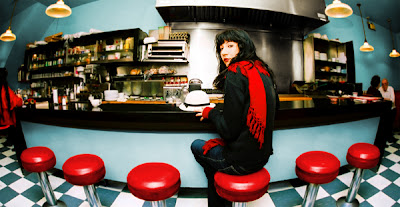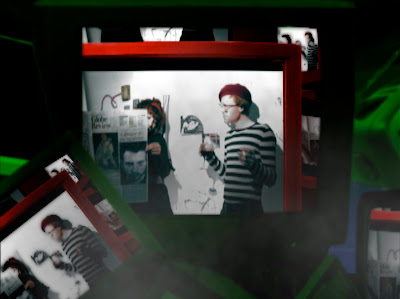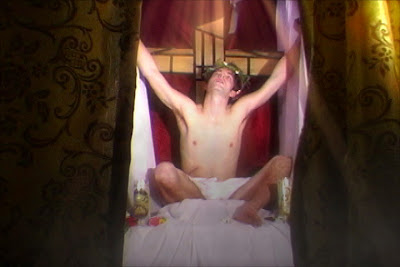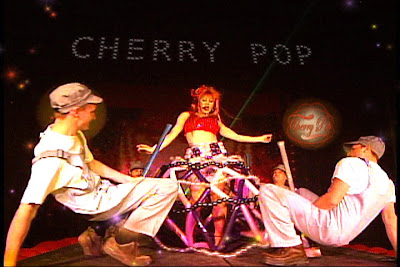 Photo by Shawn McPherson.
Photo by Shawn McPherson.1) What the fuck is going on?
Well, as we choke on the ubiquity of war, pollution, crumbling social structures and global malaise I am preparing a solo show. How dandy!
Here is the more polite, less misanthropic answer. I am finishing a master of fine arts program at The University of Guelph, then will immediately embark upon a seven-month road trip that ends in the Yukon where my partner and I have an artist residency.
2) How has your experience as a circus performer influenced the performative elements of your multimedia artwork?
I worked as a stilt walker, clown and face painter in a Toronto-based circus and as performer in an outdoor theater troupe. I toddled where other performers strode, but being in that environment with so much extraordinary talent literally tumbling around me was influential to me. Circus performers are inherently aware of and directly address the construct of the spectacle. They invoke the burlesque and grotesque, the whimsical and horrific, creating a synergy of opposing feelings that I hope to employ in my work. Also, I am not afraid of making incredibly goofy work – as long as goofy is done right. Clowns have always amazed me with their ability to emote a complex range of sentiment and meaning through a simple gesture. They provide a seemingly safe conduit to approach risqué or contentious themes.
 3) What does “performance” mean to you?
3) What does “performance” mean to you?
It is difficult to draw distinctive lines as to what is or isn’t a performance. I think that a performance is a reciprocal experience, in that the awareness of an audience adds to or affects a performer’s decision making.
Technology augments the potential for diverse performance and performance venues; performance doesn’t necessarily require the performer to be physically present with or ‘live’. The consideration of the audience I speak of does not disappear along with the physical presence of the performer – in fact one must consider their potential audience in an unprecedented manner.
For instance the Surveillance Camera Players, originally based in New York, perform for an audience that is comprised of security guards and employees of public and private spaces by means of security cameras.
A kid on YouTube performs for hordes of individual viewers, and they can respond with their own DIY performative video for the world to see and so on. Each performance is affected by the last, and the anticipation of what’s to come. It is a wonderful moment when the roles of performer and audience are blurred.
 4) Is the movement element of a kinetic sculpture a kind of performance?
4) Is the movement element of a kinetic sculpture a kind of performance?
Yes it can be, but for me the real performance occurs in the behavioral and interactive elements of the sculpture, in the experience between object and viewer. I mean, the disk drive of a computer moves, but I don’t really think of it as a performance, it is a function. Movement is a step towards animating an object, I suppose, but movement is more meaningful when it is emphasized by an experiential element brought into the equation by an audience, or viewer.
An example of this is a cartoonishly menacing six feet tall bear I made that would hug viewers who sat in its lap. Its heated stomach would then vibrate and the bear released the viewer when they moved to stand up. Without the participants action the bear was more or less a big furry chair. It was the active role of the viewer that created something interesting for others to watch, whether the viewer was cautious or unabashed, self-conscious or hammy.
 5) Do viewers of your work tend to “understand” it in terms that you feel comfortable with?
5) Do viewers of your work tend to “understand” it in terms that you feel comfortable with?
Accessibility is extremely important to me when I am considering a project. When I was just wee I made work that was deeply personal, coded, symbolic and somewhat opaque. I was disappointed when people didn’t understand what I was trying to communicate, so I decided to create work that could function within a larger cultural dialogue, allowing greater entry for an audience. A successful piece to me is something that communicates creatively yet effectively. There must be room for the viewer to consider and use their own imagination; otherwise it becomes more of an illustration of your idea than an engaging experience.
Art that draws from the world, not solely from personal experience or cultural theory that creates a discourse that is inclusive rather than esoteric is most interesting to me.
 6) Do you feel that you are part of a strong community of like-minded artists?
6) Do you feel that you are part of a strong community of like-minded artists?
I was lucky to attend OCAD in Toronto during an exciting time with some ambitious and talented people. I am still friends with many of these people, am inspired by their practice and often exhibit with them. Creative energy is contagious.
7) What does feminism mean to you?
I am not sure if there has ever been a more misunderstood word. Feminism is recognizing that it is OK to say that you are one. Feminism is unabashedly excelling in what you believe in and where your talents lie. Feminism means you don’t have to apologize for disagreeing. Feminism is realizing that it is not time to give up on feminism. I wish I was a better feminist.
 8) How do you feel about the parameters of traditional theatre (the stage, the lights, the audience)?
8) How do you feel about the parameters of traditional theatre (the stage, the lights, the audience)?
I dig it. There is a place for everything. Innovation is always exciting, and necessary, but tradition is important too.
9) Did your various art school experiences (at OCAD and the University of Guelph) prepare you well for a career as a working artist?
Nothing can prepare you to work as an artist. Everyone has to define ‘success’ on their own term and figure out what that means. There is no recipe that can be taught to navigate an art market (but if there is please let me know). School can only inform you of what already exists and its up to you to figure out what to do with that knowledge.
 10) Why is pop culture worth subverting?
10) Why is pop culture worth subverting?
Whack loads of people think that media critique has had its day in the eighties, or that it is juvenile. Should satire cease to exist? I can’t think of a time in history in which it has been more crucial. Political and capitalist entities occupy so much real estate within our attention by way of the most popular of all domestic appliances, the television. Mass media doesn’t have to be a one-way feed. Pop culture and the subversion of it should be made up of many voices, and I believe that is beginning to happen on some level. As a society we share a collective identity – that identity should be decentralized! I am very optimistic about the Internet providing a democratized venue for video, music, news and art – in short pop culture.
“As a society we share a collective identity – that identity should be decentralized!”
I don’t think I’ve ever really thought about identity in those terms (local versus global). But what a great observation.
And the democratization of pop culture through new media is another wonderful idea. I share your sense of optimism, Jennifer.
Yo Jenn,
Wow can you ever make sense . . . not a word of a lie. “Not a cough in a carload” Camels used to say.
Y’all write real good.
Have you seen Mr. Diety? Loads o’ fun.
I look forward to more of your work.
How ever do make a living?
Ritual Flourish,
Curious